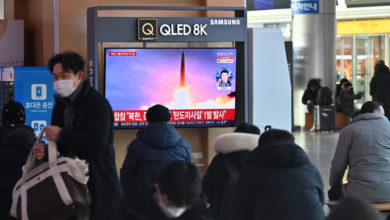A Third of U.S. Should Be Considering Masks, Officials Say

WASHINGTON — COVID-19 cases are increasing in the United States — and could get even worse over the coming months, federal health officials warned Wednesday in urging areas hardest hit to consider reissuing calls for indoor masking.
Increasing COVID-19 infection rates and hospitalizations mean that more people are being placed under the guidelines of the U.S. Centers for Disease Control and Prevention, which call for the use of masking and other precautions to prevent infections.
Right now, about a third of the U.S. population lives in areas that are considered at higher risk — mostly in the Northeast and Midwest. Those are areas where people should already be considering wearing masks indoors — but Americans elsewhere should also take notice, officials said.
“Prior increases of infections, in different waves of infection, have demonstrated that this travels across the country,” said Dr. Rochelle Walensky, the CDC director, said at a White House briefing with reporters.
For an increasing number of areas, “we urge local leaders to encourage use of prevention strategies like masks in public indoor settings and increasing access to testing and treatment,” she said.
Officials were careful not to make any predictions. They said that how bad the pandemic will get will depend on many factors. This includes whether or not previous infections have protected against new strains.
Last week, White House COVID-19 coordinator Dr. Ashish Jha warned in an interview with The Associated Press the U.S. will be increasingly vulnerable to the coronavirus this fall and winter if Congress doesn’t swiftly approve new funding for more vaccines and treatments.
Jha warned that without additional funding from Congress for the virus would cause “unnecessary loss of life” in the fall and winter, when the U.S. runs out of treatments.
He said the U.S. is now falling behind the other countries in the procurement of COVID-19-related vaccines.
Continue reading: A Million Americans have died from COVID-19. We have some stories about them
Jha stated that domestic test manufacturers have begun closing down lines and layingoff workers. If the U.S. has not raised enough money, it will sell off the equipment and exit the manufacturing business entirely.
Jha said that the U.S. would be reliant upon other countries for supplies of testing materials, putting it at risk of shortages during an increase in demand. Jha said that 8 million people placed orders to receive the eighth tranche of free testing since Monday’s opening.
Now, the pandemic has been around for 2 1/2 years. And the U.S. has seen — depending how you count them — five waves of COVID-19 during that time, with the later surges driven by mutated versions of the coronavirus. The omicron variation caused a fifth wave to occur mainly between December and January.
It spreads much faster than the earlier variants of omicron.
Many experts fear that there is a sixth wave of the nation’s population, driving by an omicron-subvariant. Walensky observed a steady rise in COVID-19-related cases over the last five weeks. This includes a 26% national increase during the week.
According to her, hospitalizations have also been increasing by 19% over the week. But they are still much lower than in the omicron wave.
In late February, as that wave was ebbing, the CDC released a new set of measures for communities where COVID-19 was easing its grip, with less of a focus on positive test results and more on what’s happening at hospitals.
Walensky stated that more than 32% live in areas with high or medium COVID-19 levels. This includes more than 9% at the highest level. CDC suggests masks and mitigation measures.
Another 8% of Americans resided in COVID-19 communities at medium or high levels for the week.
Officials expressed concern that the country’s declining immunity and loosening of mitigation measures could lead to an increase in the number and severity of infections. They encouraged people — particularly older adults — to get boosters.
Health experts believe the government needs to be more clear and bold.
The CDC community level guidelines are confusing to the public, and don’t give a clear picture of how much virus transmission is occurring in a community, said Dr. Lakshmi Ganapathi, an infectious diseases specialist at Harvard University.
When the government officials make recommendations but do not set rules, “it ultimately rests on every single individual picking and choosing the public health that works for them. But that’s not what is effective. If you’re talking about stemming hospitalizations and even deaths, all of these interventions work better when people do it collectively,” she said.
___
Stobbe was based in New York.
___
The Associated Press Health & Science Department receives support from the Howard Hughes Medical Institute’s Department of Science Education. Content is entirely the responsibility of Associated Press.
Read More From Time





